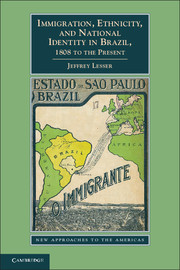Immigration, Ethnicity, and National Identity in Brazil, 1808 to the Present by Jeffrey Lesser (review)
Journal of Interdisciplinary History
Volume 45, Number 3, Winter 2015
pages 449-451
Samuel L. Baily, Professor Emeritus of History
Rutgers, The State University of New Jersey
Jeffrey Lesser, Immigration, Ethnicity, and National Identity in Brazil, 1808 to the Present (Cambridge, New York: Cambridge University Press, 2013).
Lesser’s book is an ambitious, commendable effort to explain the complex evolving relationships between immigration, ethnicity, and national identity in Brazil since 1808. Over that period of time, 6 million immigrants entered Brazil. The large majority of them were of European descent—slightly fewer than one-third of them from both Portugal and Italy, 13 percent from Spain, and 4 percent from Germany. Non-Europeans comprised nearly 20 percent of the total—Japanese about 5 percent, and Middle Eastern Jews and Arabs, Chinese, Latin Americans, and Americans the remainder. The flow of each group varied in intensity over time. Most of the immigrants settled in the southern part of the country and in the state and city of Sao Paulo, but others spread into other areas as well. Lesser seeks to analyze the impact of migration both on the immigrants themselves and on the evolving meaning of Brazilian national identity.
As daunting a task as Lesser’s may seem, the topic is further complicated by the fact that approximately 30 percent of Brazil’s population at the time of its independence in 1822 were African Brazilians, who served as the primary workforce for the colonial economy. Thus, race became intimately linked to immigration, to ethnicity, and ultimately to definitions of national identity. Immigrants did not provide labor in Brazil alone; they did so in the United States as well. But conceptions of immigrants’ standing in these two societies differed considerably. The United States saw itself as the “promised land” where immigrants could immediately improve their prospects, whereas many of the people who constituted Brazil’s host society hoped that immigrants, by virtue of their physical and cultural presence, would gradually improve an imperfect nation by ameliorating its mixed racial composition. They adopted a “whiteness model” of development. Lesser correctly insists that immigration and national identity cannot be understood separately from the broader context of race.
The book includes many important statistical tables and interesting illustrations (postage stamps, postcards, maps, photos, magazine ads, and cartoons, among others). At the end of five of the six chapters are appended relevant short primary documents related to the topics that they discussed. The work also includes a useful, comprehensive historiographical essay on Brazilian immigration, ethnicity, and national identity, but also sufficient citations to facilitate comparisons with the United States, Argentina, and other New World countries that experienced major immigrations.
Lesser previously published three books on major aspects of his current subject—one about Jewish rnigration to Brazil, the second about negotiating national identity in Brazil, and the third about Japanese Brazilians. In the present volume, he builds skillfully on this foundation of primary data and analysis to deepen our understanding of these complex issues. He organizes his book in loose chronological order beginning with a chapter about Central European and Asian migration schemes (1822–1870), followed by chapters about mass European migration (1880–1920), Middle Eastern migration (Arabs and Jews) (1880–1940), and Asian migration (especially Japanese) (1900–1955). The epilogue focuses on the post–World War II period, bringing the story to the present day. All of these chapters examine the evolving patterns of national identity, but Chapter 4 is specifically focused on the creation of Euro-Brazilian identities.
Lesser’s book has much to offer to both specialists and general readers. His overview carries profound insights about the problems of national identity in Brazil and elsewhere. One of Lesser’s greatest contributions is his effective use of comparative methodology. He clearly delineates the similarities and differences between the specific European, Middle Eastern, and Asian groups within Brazil regarding such important matters as intermarriage with Afro-Brazilians, “whiteness,” the relationship with country of origin, et al. His revealing comparisons between Brazil, the United States, and Argentina provide an important international perspective on immigration and the evolution of national identity…

